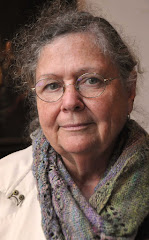 |
| It doesn't look that big... |
I do not do things by halves. My attitude has always been, "go big or go home." This can sometimes get me into trouble (see, "not knowing how to say 'No' "), but it's usually pretty interesting.
Right now, it's a big warp. When I say "big," I mean my idea of "big." I ask a lot of weavers how big a "big" warp to them is, and it's around eight to ten yards. Basically, enough to weave 8 kitchen towels. Sorry, but that's not big. My very first warp on a floor loom, way back in the dark ages, was ten yards, and when I was weaving babywraps, my "standard" warp was about 25 yards (the most fabric that would fit in the washing machine for wet-finishing). As I said, this warp is big: 100 yards of snowy white 10/2 cotton.
 |
...until seen from
from the side. |
I put a big warp on because I need towels for the business. Until this week, I was down to my last few kitchen towels, and the holiday shopping season is right around the corner. So, a great big warp is necessary to weave dozens of kitchen towels that will delight customers for the next few months.
A warp like this is a great excuse for playing with designs, especially if a weaver is lucky enough to have a computerized loom with a lot of shafts. I have 40 to play with, so a tied weave with little blocks is, for me, what Lego is to a youngster--a way to get very creative. One of my favorites is double-two-tie, a 2-end block with the ties on two alternating shafts. Basically, it's like Summer & Winter (properly called "single-two-tie), but the blocks are half the size. After subtracting 2 shafts for the ties, and 2 shafts for the selvedges, I have 36 shafts for drawing pictures. But wait--I have more! Any image that is symmetrical can be created by threading a point twill (/\/\/\), so I can "draw" any image up to 70 blocks wide. I decided to be a bit more conservative, and I limited myself to a 35-shaft point twill.
I draw out my designs on quadrille (graph) paper before transferring them to the workstation. Some might consider it "old fashioned," but I like working in this way--I can see what I'm doing, and if I change my mind, or refine a design, I can either erase what I've done, or start on a fresh sheet of paper. Once the design is complete, I create a profile draft in the weaving software.
Once the profile draft is finished, it's pretty easy to turn it into whatever weave structure I'm working with, in this case, double-two-tie. This is how I change a profile draft in the liftplan to weave double-two-tie using weaving software.
 |
Columns 1 & 2 are selvedges; 3 & 4 are tie ties; 5-39 are
the pattern shafts |
Step 1: Set up the wif and the threading. In this case, it's a 39-shaft liftplan draft. 1 & 2 are the selvedges; 3 and 4 are the ties; and 5-39 are the "pattern" shafts. Save the wif.- Step 2: Insert a pick/row between each pick/row of the profile draft in the liftplan.
- Step 3: Move 4 empty columns in the liftplan over to the far left side of the liftplan (shafts 1-4). These will be used for the selvedges and the ties.
- Step 4: On columns 1 and 2, fill in boxes alternately, just as if it was plainweave. These will control the ends that are serving as the faux floating selvedge.
- Step 5: Controlling the ties is what makes this all work, and it's surprisingly compact: just 4 picks.
That's it!
So, how crazy can you get with 35 pattern shafts threaded in point twill? Pretty crazy. I'm weaving nine different designs, in various colors. The total is somewhere around ninety 20"x30" kitchen towels, more than enough to last me until the end of the year.
 |
| The sampler with all the designs. |








